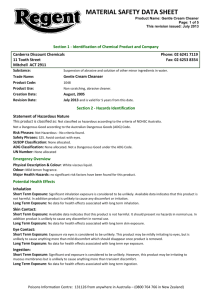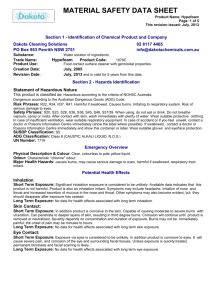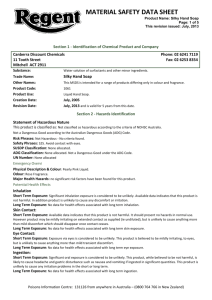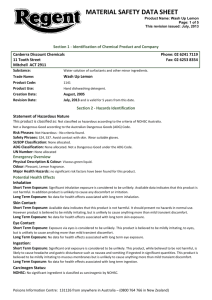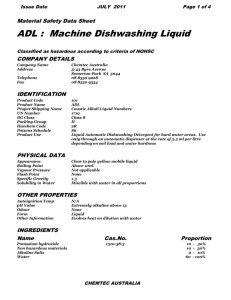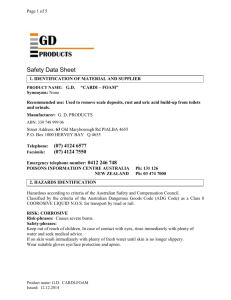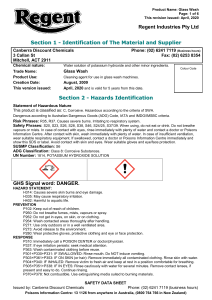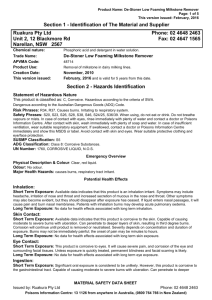Concrete cleaner
advertisement
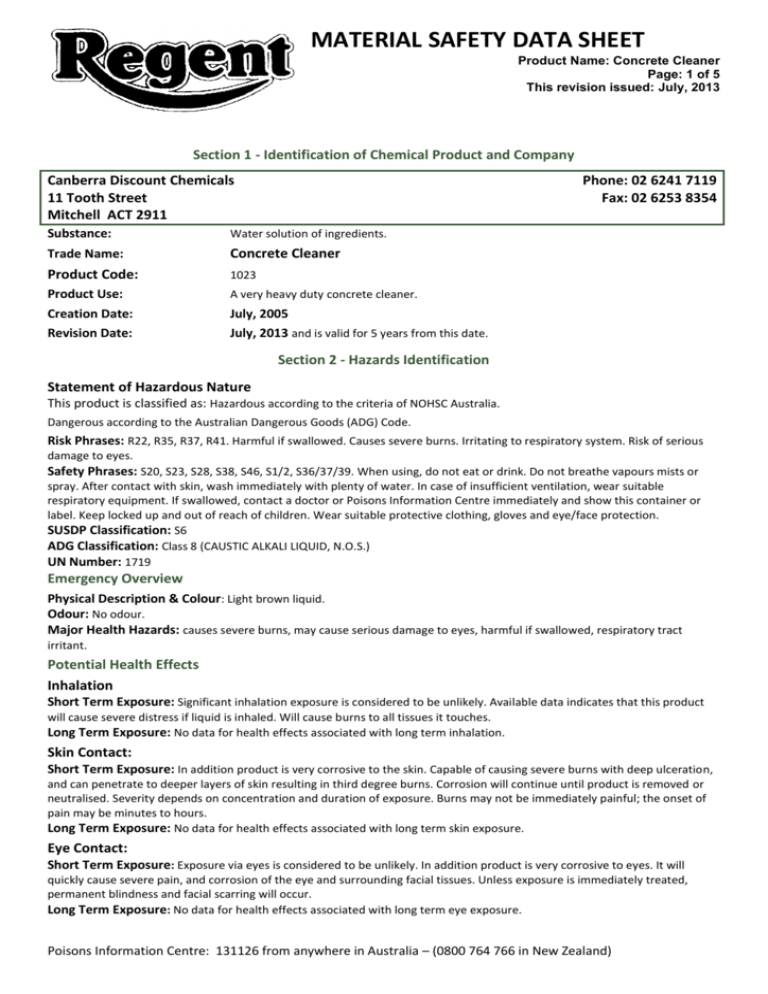
MATERIAL SAFETY DATA SHEET Product Name: Concrete Cleaner Page: 1 of 5 This revision issued: July, 2013 Section 1 - Identification of Chemical Product and Company Canberra Discount Chemicals 11 Tooth Street Mitchell ACT 2911 Phone: 02 6241 7119 Fax: 02 6253 8354 Substance: Water solution of ingredients. Trade Name: Concrete Cleaner Product Code: 1023 Product Use: Creation Date: Revision Date: A very heavy duty concrete cleaner. July, 2005 July, 2013 and is valid for 5 years from this date. Section 2 - Hazards Identification Statement of Hazardous Nature This product is classified as: Hazardous according to the criteria of NOHSC Australia. Dangerous according to the Australian Dangerous Goods (ADG) Code. Risk Phrases: R22, R35, R37, R41. Harmful if swallowed. Causes severe burns. Irritating to respiratory system. Risk of serious damage to eyes. Safety Phrases: S20, S23, S28, S38, S46, S1/2, S36/37/39. When using, do not eat or drink. Do not breathe vapours mists or spray. After contact with skin, wash immediately with plenty of water. In case of insufficient ventilation, wear suitable respiratory equipment. If swallowed, contact a doctor or Poisons Information Centre immediately and show this container or label. Keep locked up and out of reach of children. Wear suitable protective clothing, gloves and eye/face protection. SUSDP Classification: S6 ADG Classification: Class 8 (CAUSTIC ALKALI LIQUID, N.O.S.) UN Number: 1719 Emergency Overview Physical Description & Colour: Light brown liquid. Odour: No odour. Major Health Hazards: causes severe burns, may cause serious damage to eyes, harmful if swallowed, respiratory tract irritant. Potential Health Effects Inhalation Short Term Exposure: Significant inhalation exposure is considered to be unlikely. Available data indicates that this product will cause severe distress if liquid is inhaled. Will cause burns to all tissues it touches. Long Term Exposure: No data for health effects associated with long term inhalation. Skin Contact: Short Term Exposure: In addition product is very corrosive to the skin. Capable of causing severe burns with deep ulceration, and can penetrate to deeper layers of skin resulting in third degree burns. Corrosion will continue until product is removed or neutralised. Severity depends on concentration and duration of exposure. Burns may not be immediately painful; the onset of pain may be minutes to hours. Long Term Exposure: No data for health effects associated with long term skin exposure. Eye Contact: Short Term Exposure: Exposure via eyes is considered to be unlikely. In addition product is very corrosive to eyes. It will quickly cause severe pain, and corrosion of the eye and surrounding facial tissues. Unless exposure is immediately treated, permanent blindness and facial scarring will occur. Long Term Exposure: No data for health effects associated with long term eye exposure. Poisons Information Centre: 131126 from anywhere in Australia – (0800 764 766 in New Zealand) Product Name: Concrete Cleaner Page: 2 of 5 This revision issued: February, 2016 Ingestion: Short Term Exposure: Significant oral exposure is considered to be unlikely. Available data shows that this product is harmful, but symptoms are not available. However, this product is very corrosive to the gastrointestinal tract. Capable of causing severe burns with deep ulceration, and can penetrate to deeper layers of skin resulting in third degree burns. Corrosion will continue until product is removed or neutralised. Severity depends on concentration and duration of exposure. Long Term Exposure: No data for health effects associated with long term ingestion. Carcinogen Status: NOHSC: No significant ingredient is classified as carcinogenic by NOHSC. NTP: No significant ingredient is classified as carcinogenic by NTP. IARC: Triethanolamine is Class 3 - unclassifiable as to carcinogenicity to humans. See the IARC website for further details. A web address has not been provided as addresses frequently change. Section 3 - Composition/Information on Ingredients Ingredients CAS No Conc, % TWA (mg/m3) STEL (mg/m3) Potassium hydroxide 1310-58-3 8.5 2 Peak Sodium hydroxide 1310-73-2 9.8 2 Peak Triethanolamine 102-71-6 4.5 5 not set Other non hazardous ingredients various 5-10 not set not set Water 7732-18-5 to 100 not set not set This is a commercial product whose exact ratio of components may vary slightly. Minor quantities of other non hazardous ingredients are also possible. The TWA exposure value is the average airborne concentration of a particular substance when calculated over a normal 8 hour working day for a 5 day working week. The STEL (Short Term Exposure Limit) is an exposure value that should not be exceeded for more than 15 minutes and should not be repeated for more than 4 times per day. There should be at least 60 minutes between successive exposures at the STEL. The term "peak "is used when the TWA limit, because of the rapid action of the substance, should never be exceeded, even briefly. Section 4 - First Aid Measures General Information: You should call The Poisons Information Centre if you feel that you may have been poisoned, burned or irritated by this product. The number is 13 1126 from anywhere in Australia (0800 764 766 in New Zealand) and is available at all times. Have this MSDS with you when you call. Inhalation: If inhalation occurs, contact a Poisons Information Centre, or call a doctor at once. Remove source of contamination or move victim to fresh air. If breathing is difficult, oxygen may be beneficial if administered by trained personnel, preferably on a doctor's advice. DO NOT allow victim to move about unnecessarily. Symptoms of pulmonary oedema can be delayed up to 48 hours after exposure. Skin Contact: Seek urgent medical attention. Flush contaminated area with lukewarm, gently flowing water for at least 60 minutes, by the clock. DO NOT INTERRUPT FLUSHING. If necessary, keep emergency vehicle waiting (show paramedics this MSDS and take their advice). Under running water, remove contaminated clothing, shoes and leather goods (e.g. watchbands, belts). Strongly basic ingredients tend to penetrate the skin and so need longer rinsing than other substances. Eye Contact: Immediately flush the contaminated eye(s) with lukewarm, gently flowing water for at least 60 minutes, by the clock, while holding the eyelid(s) open. Neutral saline solution may be used as soon as it is available. DO NOT INTERRUPT FLUSHING. If necessary, keep emergency vehicle waiting (show paramedics this MSDS and take their advice). Take care not to rinse contaminated water into the unaffected eye or onto face. Call a Poisons Information Centre or a doctor urgently. Ingestion: If swallowed, rinse mouth thoroughly with water and contact a Poisons Information Centre. Urgent hospital treatment is likely to be needed. Give activated charcoal if instructed. Section 5 - Fire Fighting Measures Fire and Explosion Hazards: There is no risk of an explosion from this product under normal circumstances if it is involved in a fire. This product is likely to decompose only after heating to dryness, followed by further strong heating. Fire decomposition products from this product are not expected to be hazardous or harmful. Extinguishing Media: Not Combustible. Use extinguishing media suited to burning materials. Water fog or fine spray is the preferred medium for large fires. Aim to dilute the material with large quantities of water. If practical, contain diluted material and prevent from entering drains and water courses. MATERIAL SAFETY DATA SHEET Issued by: Canberra Discounts Chemicals Phone: 02 6241 7119 Poisons Information Centre: 131126 from anywhere in Australia – (0800 764 766 in New Zealand) Product Name: Concrete Cleaner Page: 3 of 5 This revision issued: February, 2016 Fire Fighting: If a significant quantity of this product is involved in a fire, call the fire brigade. Flash point: Does not burn. Upper Flammability Limit: Does not burn. Lower Flammability Limit: Does not burn. Autoignition temperature: Not applicable - does not burn. Flammability Class: Does not burn. Section 6 - Accidental Release Measures Accidental release: In the event of a major spill, prevent spillage from entering drains or water courses. Evacuate the spill area and deny entry to unnecessary and unprotected personnel. Wear full protective chemically resistant clothing including eye/face protection, gauntlets and self contained breathing apparatus. See below under Personal Protection regarding Australian Standards relating to personal protective equipment. Suitable materials for protective clothing include rubber, Viton, Nitrile, butyl rubber, Barricade, neoprene, Teflon, polyethylene, PE/EVAL, Saranex, Responder. Eye/face protective equipment should include a full face shield. If there is a significant chance that vapours or mists are likely to build up in the cleanup area, we recommend that you use a respirator. Usually, no respirator is necessary when using this product. However, if you have any doubts consult the Australian Standard mentioned below (section 8). Stop leak if safe to do so, and contain spill. Absorb onto sand, vermiculite or other suitable absorbent material. If spill is too large or if absorbent material is not available, try to create a dike to stop material spreading or going into drains or waterways. Because of the corrosiveness of this product, special personal care should be taken in any cleanup operation. Sweep up and shovel or collect recoverable product into labelled containers for recycling or salvage, and dispose of promptly. Recycle containers wherever possible after careful cleaning. After spills, wash area preventing runoff from entering drains. If a significant quantity of material enters drains, advise emergency services. Contaminated area may be neutralised by washing with weak or dilute acid. Vinegar, citrus juice and most soft drinks may be suitable. This material may be suitable for approved landfill. Ensure legality of disposal by consulting regulations prior to disposal. Thoroughly launder protective clothing before storage or re-use. Advise laundry of nature of contamination when sending contaminated clothing to laundry. Section 7 - Handling and Storage Handling: Keep exposure to this product to a minimum, and minimise the quantities kept in work areas. Check Section 8 of this MSDS for details of personal protective measures, and make sure that those measures are followed. The measures detailed below under "Storage" should be followed during handling in order to minimise risks to persons using the product in the workplace. Also, avoid contact or contamination of product with incompatible materials listed in Section 10. Storage: This product is a Scheduled Poison. Observe all relevant regulations regarding sale, transport and storage of this schedule of poison. Store in a cool, well ventilated area. Check containers periodically for corrosion and leaks. Containers should be kept closed in order to minimise contamination. Make sure that the product does not come into contact with substances listed under "Incompatibilities" in Section 10. If you keep more than 500kg or 500L of Corrosive Substances of Packaging Group II, you are probably required to license the premises or notify your Dangerous Goods authority. If you have any doubts, we suggest you contact your Dangerous Goods authority in order to clarify your obligations. Check packaging - there may be further storage instructions on the label. Section 8 - Exposure Controls and Personal Protection The following Australian Standards will provide general advice regarding safety clothing and equipment: Respiratory equipment: AS/NZS 1715, Protective Gloves: AS 2161, Industrial Clothing: AS2919, Industrial Eye Protection: AS1336 and AS/NZS 1337, Occupational Protective Footwear: AS/NZS2210. Exposure Limits TWA (mg/m3) STEL (mg/m3) Potassium hydroxide 2 Peak Sodium hydroxide 2 Peak Triethanolamine 5 not set No special equipment is usually needed when occasionally handling small quantities. The following instructions are for bulk handling or where regular exposure in an occupational setting occurs without proper containment systems. Ventilation: No special ventilation requirements are normally necessary for this product. However make sure that the work environment remains clean and that vapours and mists are minimised. Eye Protection: Your eyes must be completely protected from this product by splash resistant goggles with face shield. All surrounding skin areas must be covered. Emergency eye wash facilities must also be available in an area close to where this product is being used. MATERIAL SAFETY DATA SHEET Issued by: Canberra Discounts Chemicals Phone: 02 6241 7119 Poisons Information Centre: 131126 from anywhere in Australia – (0800 764 766 in New Zealand) Product Name: Concrete Cleaner Page: 4 of 5 This revision issued: February, 2016 Skin Protection: Because of the dangerous nature of this product, make sure that all skin areas are completely covered by impermeable gloves, overalls, hair covering, apron and face shield. See below for suitable material types. Protective Material Types: We suggest that protective clothing be made from the following materials: rubber, Viton, nitrile, butyl rubber, Barricade, neoprene, Teflon, polyethylene, PE/EVAL, Saranex, Responder. Respirator: Usually, no respirator is necessary when using this product. However, if you have any doubts consult the Australian Standard mentioned above. Eyebaths or eyewash stations and safety deluge showers should be provided near to where this product is being used. Section 9 - Physical and Chemical Properties: Physical Description & colour: Odour: Boiling Point: Freezing/Melting Point: Volatiles: Vapour Pressure: Vapour Density: Specific Gravity: Water Solubility: pH: Volatility: Odour Threshold: Evaporation Rate: Coeff Oil/water Distribution: Autoignition temp: Light brown liquid. No odour. Approximately 100°C at 100kPa. Below 0°C. Water component. 2.37 kPa at 20°C (water vapour pressure). No data. Approx 1.25 Completely soluble in water. Very corrosive No data. No data. No data. No data Not applicable - does not burn. Section 10 - Stability and Reactivity Reactivity: Most strong alkalis and bases react with inorganic and organic acids to form salts. They can also react with some metals liberating hydrogen gas. These reactions may be rapid and sometimes liberate much heat. They can also decompose many organic materials such as esters, in a reaction called hydrolysis. Conditions to Avoid: This product should be kept in a cool place, preferably below 30°C. Incompatibilities: acids, zinc, tin, aluminium and their alloys. Fire Decomposition: This product is likely to decompose only after heating to dryness, followed by further strong heating. Polymerisation: This product will not undergo polymerisation reactions. Section 11 - Toxicological Information Local Effects: Target Organs: skin and eyes Classification of Hazardous Ingredients Ingredient Risk Phrases Potassium Hydroxide Sodium Hydroxide >=5%Conc<25%: C; R35 Conc>=5%: C; R35 Section 12 - Ecological Information This product does not degrade naturally. It will not cause ecological problems because it does not enter biological systems. Section 13 - Disposal Considerations Disposal: Containers should be emptied as completely as practical before disposal. If possible, recycle containers either inhouse or send to recycle company. If this is not practical, send to a commercial waste disposal site. Please do NOT dispose into sewers or waterways. MATERIAL SAFETY DATA SHEET Issued by: Canberra Discounts Chemicals Phone: 02 6241 7119 Poisons Information Centre: 131126 from anywhere in Australia – (0800 764 766 in New Zealand) Product Name: Concrete Cleaner Page: 5 of 5 This revision issued: February, 2016 Section 14 - Transport Information ADG Code: 1719, CAUSTIC ALKALI LIQUID, N.O.S. Hazchem Code: 2R Special Provisions: SP109, SP184, SP274 Dangerous Goods Class: Class 8, Corrosive Substances. Packaging Group: II Packaging Method: 3.8.8, RT8 Class 8 Corrosive Substances shall not be loaded in the same vehicle or packed in the same freight container with Classes 1 (Explosives), 4.3 (Dangerous When Wet Substances), 5.1 (Oxidising Agents), 5.2 (Organic Peroxides), 6 (Toxic Substances where the Toxic Substances are cyanides and the Corrosives are acids), 7 (Radioactive Substances), Foodstuffs and foodstuff empties. They may however be loaded in the same vehicle or packed in the same freight container with Classes 2.1 (Flammable Gases), 2.2 (Non-Flammable, Non-Toxic Gases), 2.3 (Poisonous Gases), 3 (Flammable liquids), 4.1 (Flammable Solids), 4.2 (Spontaneously Combustible Substances), 6 (Toxic Substances except where the Toxic Substances are cyanides and the Corrosives are acids) and 9 (Miscellaneous Dangerous Goods). Section 15 - Regulatory Information AICS: All of the significant ingredients in this formulation are to be found in the public AICS Database. The following ingredients: Potassium hydroxide, sodium hydroxide, triethanolamine, are mentioned in the SUSDP. Section 16 - Other Information This MSDS contains only safety-related information. For other data see product literature. Acronyms: ADG Code AICS CAS Number Hazchem Code IARC NOHSC NOS NTP R-Phrase SUSDP UN Number Australian Code for the Transport of Dangerous Goods by Road and Rail Australian Inventory of Chemical Substances Chemical Abstracts Service Registry Number Emergency action code of numbers and letters that provide information to emergency services especially firefighters International Agency for Research on Cancer National Occupational Health and Safety Commission Not otherwise specified National Toxicology Program (USA) Risk Phrase Standard for the Uniform Scheduling of Drugs & Poisons United Nations Number THIS MSDS SUMMARISES OUR BEST KNOWLEDGE OF THE HEALTH AND SAFETY HAZARD INFORMATION OF THE PRODUCT AND HOW TO SAFELY HANDLE AND USE THE PRODUCT IN THE WORKPLACE. EACH USER MUST REVIEW THIS MSDS IN THE CONTEXT OF HOW THE PRODUCT WILL BE HANDLED AND USED IN THE WORKPLACE. IF CLARIFICATION OR FURTHER INFORMATION IS NEEDED TO ENSURE THAT AN APPROPRIATE RISK ASSESSMENT CAN BE MADE, THE USER SHOULD CONTACT THIS COMPANY SO WE CAN ATTEMPT TO OBTAIN ADDITIONAL INFORMATION FROM OUR SUPPLIERS OUR RESPONSIBILITY FOR PRODUCTS SOLD IS SUBJECT TO OUR STANDARD TERMS AND CONDITIONS, A COPY OF WHICH IS SENT TO OUR CUSTOMERS AND IS ALSO AVAILABLE ON REQUEST. Please read all labels carefully before using product. This MSDS is prepared in accord with the NOHSC document “National Code of Practice for the Preparation of Material Safety Data Sheets” 2nd Edition [NOHSC:2011(2003)] Copyright © Kilford & Kilford Pty Ltd, February, 2016. http://www.kilford.com.au/ Phone (02)9251 4532 MATERIAL SAFETY DATA SHEET Issued by: Canberra Discounts Chemicals Phone: 02 6241 7119 Poisons Information Centre: 131126 from anywhere in Australia – (0800 764 766 in New Zealand)
